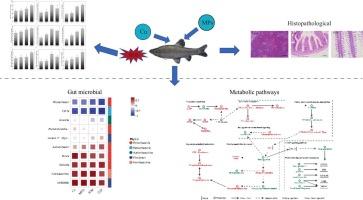Combined effects of microplastics and copper on antioxidant capacity, gut microbiome, and metabolomics of Pseudorasbora parva
IF 4.3
3区 环境科学与生态学
Q2 BIOCHEMISTRY & MOLECULAR BIOLOGY
Comparative Biochemistry and Physiology C-toxicology & Pharmacology
Pub Date : 2025-07-22
DOI:10.1016/j.cbpc.2025.110295
引用次数: 0
Abstract
Microplastics (MPs) and metal pollutants such as copper (Cu) are common pollutants in aquatic environments worldwide, posing a potential threat to the health of aquatic organisms and ecosystems. In this study, we investigated the effects of single and combined exposures of MPs (1 mg/L) and Cu (50 μg/L) on the antioxidant capacity, histopathology, gut microbiota, and metabolomics of Pseudorasbora parva which was used as a model organism. Results showed that exposure to both Cu and MPs in combination reduced Cu accumulation in tissues, mitigating the effects of Cu-induced oxidative damage. Histopathological analysis revealed that combined exposures resulted in lower levels of tissue damage than exposure to Cu alone, as evidenced by reduced leukocyte infiltration in hepatocytes, the mitigation of intestinal mucosal damage and improved gill filament epithelial cell integrity. Gut microbial community analysis showed that higher Cu concentrations significantly increased the abundance of Fusobacteriota and Cetobacterium. Metabolomics analysis revealed that in the group exposed to both Cu and MPs, compared to the Cu group, the metabolism of nucleotides, pyrimidine and glycerophospholipids was upregulated, enhancing cellular repair and defense, while the downregulation of other pathways reduced energy expenditure and prevented reaction excess. This study demonstrated that P. parva responded to multiple pollutant stress through a complex range of metabolic regulatory mechanisms, providing novel insights into the molecular response mechanisms of aquatic organisms to the combined stress of multiple pollutants, which is of great significance for aquatic ecological risk assessments.

微塑料和铜对小假螺旋藻抗氧化能力、肠道微生物组和代谢组学的联合影响
微塑料(MPs)和铜(Cu)等金属污染物是全球水生环境中常见的污染物,对水生生物和生态系统的健康构成潜在威胁。在这项研究中,我们研究了单独和联合暴露MPs (1 mg/L)和Cu (50 μg/L)对作为模式生物的小伪螺旋藻的抗氧化能力、组织病理学、肠道微生物群和代谢组学的影响。结果表明,Cu和MPs联合暴露可减少组织中Cu的积累,减轻Cu引起的氧化损伤。组织病理学分析显示,与单独暴露相比,联合暴露导致的组织损伤水平较低,肝细胞中白细胞浸润减少,肠黏膜损伤减轻,鳃丝上皮细胞完整性改善。肠道微生物群落分析表明,较高的Cu浓度显著增加了梭杆菌和鲸杆菌的丰度。代谢组学分析显示,与Cu组相比,同时暴露于Cu和MPs组,核苷酸、嘧啶和甘油磷脂的代谢上调,增强了细胞的修复和防御能力,而其他途径的下调减少了能量消耗,防止了反应过度。本研究表明,parva通过一系列复杂的代谢调控机制应对多种污染物胁迫,为水生生物对多种污染物联合胁迫的分子响应机制提供了新的认识,对水生生态风险评价具有重要意义。
本文章由计算机程序翻译,如有差异,请以英文原文为准。
求助全文
约1分钟内获得全文
求助全文
来源期刊
CiteScore
7.50
自引率
5.10%
发文量
206
审稿时长
30 days
期刊介绍:
Part C: Toxicology and Pharmacology. This journal is concerned with chemical and drug action at different levels of organization, biotransformation of xenobiotics, mechanisms of toxicity, including reactive oxygen species and carcinogenesis, endocrine disruptors, natural products chemistry, and signal transduction with a molecular approach to these fields.

 求助内容:
求助内容: 应助结果提醒方式:
应助结果提醒方式:


